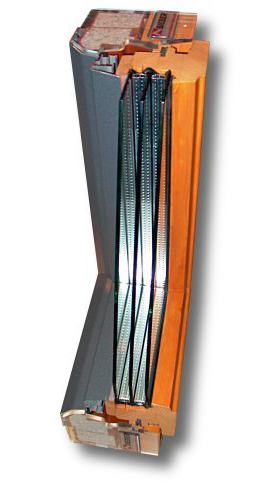
Image Credit: Bieber
[Editor’s note: Roger and Lynn Normand are building a [no-glossary]Passivhaus[/no-glossary] in Maine. This is the 11th article in a series that will follow their project from planning through construction.]
There’s a popular saying here in Maine — “we’re all set” — to signify that the current situation is perfectly fine.
Window selection had so far been the most time-consuming and vexing aspect of the EdgewaterHaus project. That was all behind us. We had made a final decision on an Optiwin-designed Bieber-manufactured Passivhaus-certified windows.
We had:
- exchanged a few draft proposals refining the window specifications;
- determined the exterior color (green);
- opted to use FSC certified european pine for the window frame;
- picked hardware style and color (contemporary look in silver finish);
- chosen to have standard European-style vertical hinges rather than the no-cost optional concealed horizontal hinges;
- selected a factory-applied interior stain color on the pine wood (a mid tone oak shade);
- identified which windows required screens (all but the garage and a window at the top of the stairs to the lower);
- approved detailed shop drawings of all the windows;
- signed a sales contract;
- made two down payments totaling some 50% of the delivered cost of the windows;
- received word from Bieber that production of our windows was underway.
So, we were all set on windows.
Bieber lacks the authority to sell these windows in the U.S.
Not so, as it turned out.
We got a call in mid-June from Bieber advising us that they would not be able to deliver the windows we had bought because of licensing issues. Optiwin licenses their window design to Bieber and other manufacturers to produce and sell. We were told that Optiwin had just withdrawn Bieber’s authority to ship the Optiwin designed window to the U.S. market.
Of course, our first reaction was disbelief. How could that be, we wondered? We had a signed contract with Bieber containing “irrevocable” legalities. Surely, our contract must be “grandfathered,” and thus should — no, must — be honored.
The shock quickly wore off to the reality of the situation. Bieber offered to return all our money. We could start anew with our runner-up window Intus. But workers were already assembling the foundation. We could easily foresee one or more months preparing and reviewing shop drawings and other decision points before even placing the order. The building shell would be completed months before the replacement windows arrived. What havoc would that bring to the construction schedule?
We momentarily considered legal remedies – sue ’em for noncompliance with the contract. But how long would that prolong the situation, how much would that cost, and how much anguish would that create for us?
We’re not the litigious type. Let’s find a reasonable alternative.
Will you accept a substitution?
To his credit, Benoit, our Bieber salesman in New York City, was genuinely distressed and apologetic about the situation and wanted to find an acceptably accommodation. In lieu of a refund, Bieber offered to provide their more expensive, Bieber-designed Bi-Passif window at no additional cost. We looked at pictures of the windows and liked what we saw. It’s also a Passivhaus-certified window with slightly different aesthetics, installation, and performance — the U-factor is a bit better, but the frame dimensions and spacers a bit worse. We are talking three-decimal-place differences.
Would any of this affect the Annual Heat Demand and our Passive House Design Stage Assurance from the Passive House Academy? We would not know until the new values were entered into the the Passive House Planning Package. Benoit offered to reimburse us for our architectural and energy consultant costs for switching to the Bi-Passiv, and a further discount on screens. That sounded fair to us.
So our architect, Chris Briley, adapted the Bi-Passiv window to the EdgewaterHaus design, and PHA re-ran the PHPP model. The results: no significant impact on the PHPP; no change in the window shop drawings; some slight modifications to the exterior and interior detailing.
Problem resolved within about 2 weeks. We were once again all set on windows.
But you’ll have to accept different glass …
Not so, as it turned out.
A few weeks later, Benoit called to say there was a supplier issue on the 0.63 SHGC glass that Bieber had quoted. He proposed to substitute 0.62 SHGC glass that had a slightly better U-factor. Here we go again on three-decimal-place window metrics!
Again, a happy ending. Passive House Academy confirmed that the better U-factor trumped the slightly lower SHGC.
Yep, we’re all set on windows.
Mais voyons — on ne travaille pas le mois d’août
Not yet.
Like many manufacturers throughout France, Bieber shuts production down during three weeks in August for employee vacations. We were hoping that Bieber would make our windows before the vacation period. Benoit advised us that Bieber’s supplier had not provided the aluminum cladding for our windows before the start of their August shut-down.
Production of our windows would not be completed until the first week in September. With a three-week trans-Atlantic shipping, we should get our Bi-Passif windows on site by the end of September.
I initially thought that would delay our ability to do our first blower-door test. But as we have learned, nothing, absolutely no construction-related activities happen on schedule.
For example, the framers have waited for over one week to receive the necessary 60-degree hangers to complete the floor framing. When the hangers finally arrived from Coastal Forest Products, they were a face-mount rather than the top-mount we expected. Why can’t Coastal provide the proper components for the floor framing package they designed? We have been delayed for nearly two weeks on completing the floor deck, which delays erecting the walls, which delays placing the roof trusses, which … well, you get the picture.
Now, we wait
So we await word that Bieber has completed production of our windows at their plant in Alsace, France, and are preparing to ship them to us. We’re not sure what happened “behind the curtain” between Beiber and Optiwin, but feel that Beiber has done their best to help us resolve this to our satisfaction. As for the shipping delay, well, with all the construction delays, the windows may yet arrive just in time.
So for right now … we are again all set on windows … until further notice!
The first article in this series was Kicking the Tires on a Passivhaus Project. Roger Normand’s construction blog is called EdgewaterHaus.
Weekly Newsletter
Get building science and energy efficiency advice, plus special offers, in your inbox.





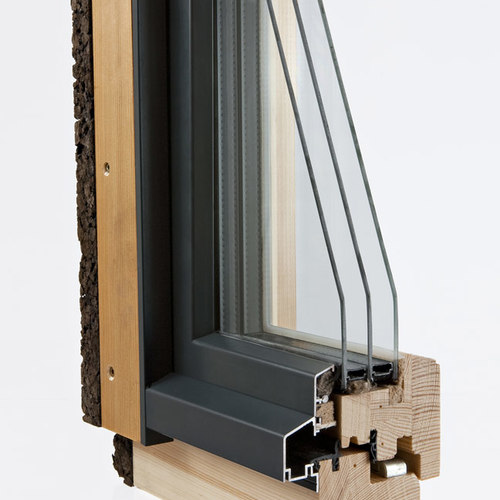
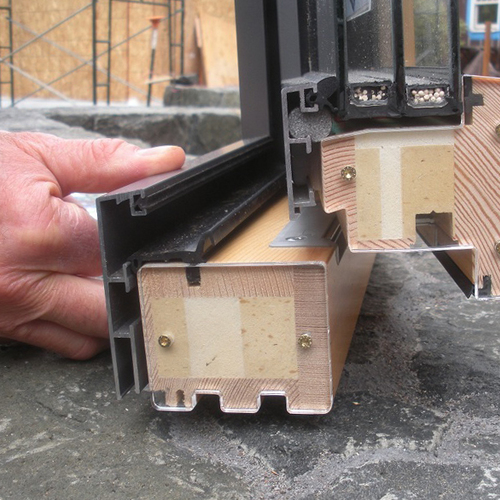
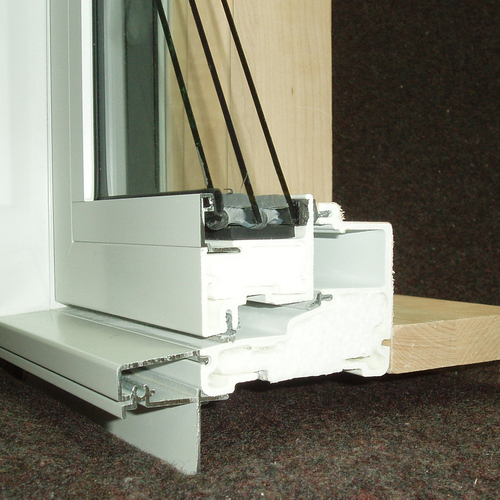
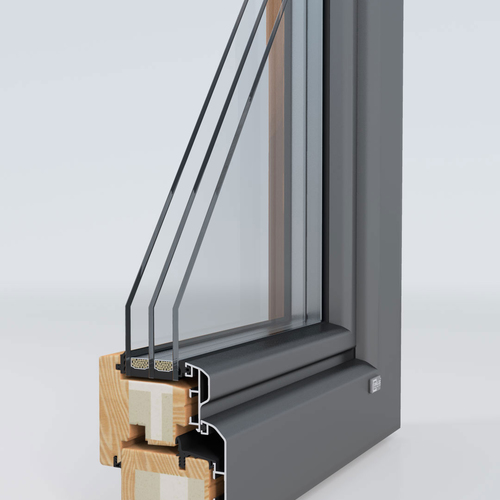






3 Comments
We went with Intus
We just got our Intus windows delivered and they look great. No problems, but it did take 3 and a half months from order to delivery. I can't wait to see them up.
Ouch - and a light (workshop) at the end of the tunnel
Roger,
Looks like you've been hit with every ounce of bad luck available and I'm impressed that you're persevering. Your experience is unfortunately not uncommon and highlights both the complexity of PH window selection, and the perils of the import business. (I speak from experience on both counts.)
There is some good news though. Because people such as yourself have been willing to build to PH levels, there is growing interest in building PH certified windows right here in the US. The American Passive House Network has initiated a workshop, to be conducted by the Passive House Institute, to help local window manufacturers build and certify their own products. (At under $3K to obtain certification, it is also extremely affordable for smaller shops.) The workshop will include training for local NFRC accredited simulators so they may work with these local shops and then become PHI accredited simulators. It will be held on Nov. 16th in San Francisco, directly after Greenbuild.
So far, there has been an incredible response to this workshop with over 20 manufacturers and 3 simulators registered so far. I'm hoping a few more will sign up and that some of them will be near you. (Right now we have all West and Central manufacturers - no East Coast one's just yet.) Details and more info on the workshop can be found here: http://www.aphnetwork.org/events-schedule/phi-window-certification-workshop. Please feel free to send this link to small, local shops whom you think are willing/able to step up to build high performance products. We'll all benefit from this in the long term.
Otherwise, hang in there and I hope your windows all arrive in one piece.
Product Declaration
It is interesting how the advent of the green building movement has shifted the sourcing process for products. Especially with some of the restrictions of LEED and other ratings systems, we are seeing cases where products are actually purchased from overseas. This certainly adds a new wrinkle in the build process. In this case, it seems like there were some issues with the sourcing of these windows. I think transparency with regard to product attributes is going to be paramount to sustaining the momentum of the sustainable building industry. We need local manufacturers to get on board with declaration, otherwise we will continue to see products purchased abroad. Manufacturers need to change with the times.
http://blog.greenwizard.com/wp/2012/10/check-the-label/
Log in or create an account to post a comment.
Sign up Log in